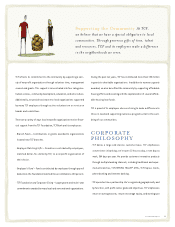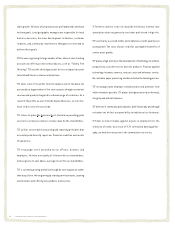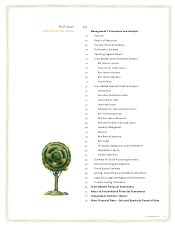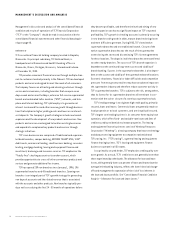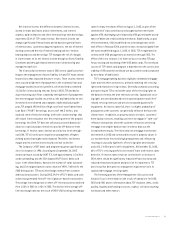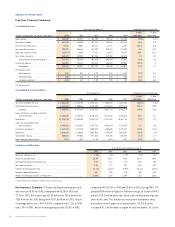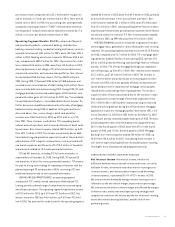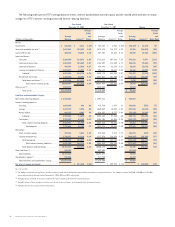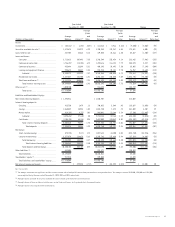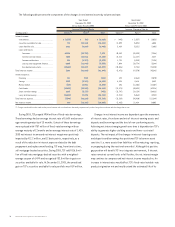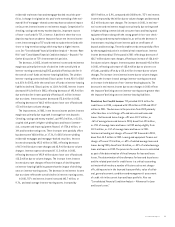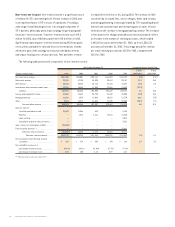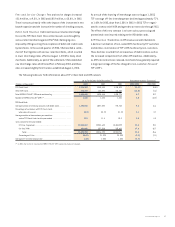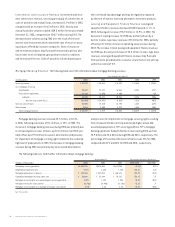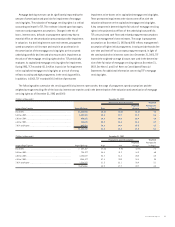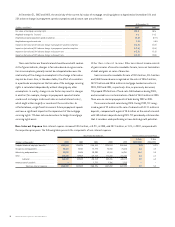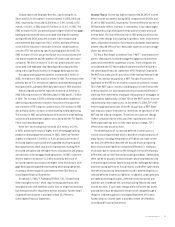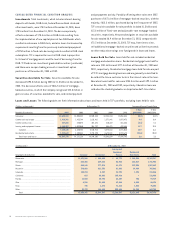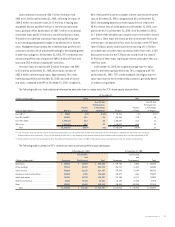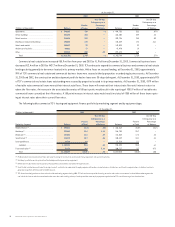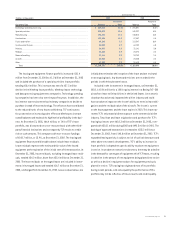TCF Bank 2003 Annual Report Download - page 27
Download and view the complete annual report
Please find page 27 of the 2003 TCF Bank annual report below. You can navigate through the pages in the report by either clicking on the pages listed below, or by using the keyword search tool below to find specific information within the annual report.
2003 Annual Report 25
residential real estate loan and mortgage-backed securities port-
folios. A change in origination mix and/or the extending of the esti-
mated life of mortgage-related assets may have an adverse impact
on future net interest income or net interest margin. Competition for
checking, savings and money market deposits, important sources
of lower-cost funds for TCF, is intense. A decline in these low-cost
deposits may have an adverse impact on future net interest income
or net interest margin as TCF would need to replace these funds with
short- or long-term borrowings which may have a higher interest
cost. See “Consolidated Financial Condition Analysis – Interest-Rate
Risk” and “Consolidated Financial Condition Analysis – Deposits” for
further discussion on TCF’s interest rate risk position.
The decrease, in 2003, in both net interest income and net interest
margin was primarily the result of a decline in the overall yield on
interest-earning assets during 2003, partially offset by a decline in
the overall cost of funds on interest-bearing liabilities. The yield on
interest-earning assets declined 87 basis points from 6.92% for 2002
to 6.05% for 2003, while the overall cost of funds on interest-bearing
liabilities declined 72 basis points to 1.56% for 2003. Interest income
decreased $91.8 million in 2003, reflecting decreases of $92.9 million
due to the decline in rates partially offset by a $1 million increase
due to volume. Interest expense decreased $73.8 million in 2003,
reflecting decreases of $66.2 million due to lower cost of funds and
$7.5 million due to volume changes.
The improvement, in 2002, in net interest income and net interest
margin was primarily due to growth in average low-cost deposits
(checking, savings and money market), up $997.8 million, or 23.2%,
coupled with growth in higher-yielding loans and leases (commer-
cial, consumer and lease equipment finance) of $724.6 million, or
14% and lower borrowing costs. These increases were partially offset
by a decrease of $850 million, or 17.1%, for 2002 in lower-yielding
residential mortgages and mortgage-backed securities. Interest
income decreased by $93.2 million in 2002, reflecting decreases
of $87.4 million due to rate changes and $5.9 million due to volume
changes. Interest expense decreased $111.2 million in 2002,
reflecting decreases of $95.9 million due to lower cost of funds and
$15.3 million due to volume changes. The increase in net interest
income due to rate changes reflects the impact of declining rates
on interest-bearing liabilities greater than the impact of declining
rates on interest-earning assets. The decrease in net interest income
due to volume reflects the overall decline in interest-earning assets.
In 2001, TCF’s net interest income increased $42.7 million, or
9.7%, and total average interest-earning assets increased by
$592.9 million, or 5.9%, compared with 2000 levels. TCF’s net interest
income improved by $46 million due to volume changes and decreased
$3.3 million due to rate changes. The increases in 2001, in net inter-
est income and net interest margin were primarily due to the growth
in higher yielding commercial and consumer loans and leasing and
equipment finance along with the strong growth in low-cost check-
ing, savings and money market deposits, as well as the decrease in
interest rates resulting in lower interest paid on certificates of
deposit and borrowings. These favorable trends were partially offset
by the managed reduction in residential real estate loans. Interest
income decreased by $72 thousand in 2001 reflecting a decrease of
$56.7 million due to rate changes, offset by an increase of $56.6 mil-
lion due to volume changes. Interest expense decreased $42.8 million
in 2001, reflecting a decrease of $53.4 million due to a lower cost
of funds, partially offset by a $10.6 million increase due to volume
changes. The increase in net interest income due to volume changes
reflects the increase in total average interest-earning assets and
an increase in the balance of non-interest-bearing deposits. The
decrease in net interest income due to rate changes in 2001 reflects
the impact of declining rates on interest-earning assets greater than
the impact of declining rates on interest-bearing liabilities.
Provision for Credit Losses TCF provided $12.5 million for
credit losses in 2003, compared with $22 million in 2002 and $20.9
million in 2001. The decrease in the provision from 2002 primarily
reflect declines in net charge-offs and non-accrual loans and
leases. Net loan and lease charge-offs were $12.9 million, or
.16% of average loans and leases in 2003, down from $20 million,
or .25% of average loans and leases in 2002 and up slightly from
$12.5 million, or .15% of average loans and leases in 2001.
Commercial lending net charge-offs were $782 thousand in 2003,
down from $5.9 million in 2002. Leasing and equipment finance net
charge-offs were $7.5 million, or .69% of related average loans and
leases during 2003, down from $8 million, or .80% of related average
loans and leases in 2002. The provision for credit losses is calculated
as part of the determination of the allowance for loan and lease
losses. The determination of the allowance for loan and lease losses
and the related provision for credit losses is a critical accounting
estimate which involves a number of factors such as net charge-
offs, delinquencies in the loan and lease portfolio, value of collat-
eral, general economic conditions and management’s assessment
of credit risk in the current loan and lease portfolio. Also see
“Consolidated Financial Condition Analysis – Allowance for Loan
and Lease Losses.”


